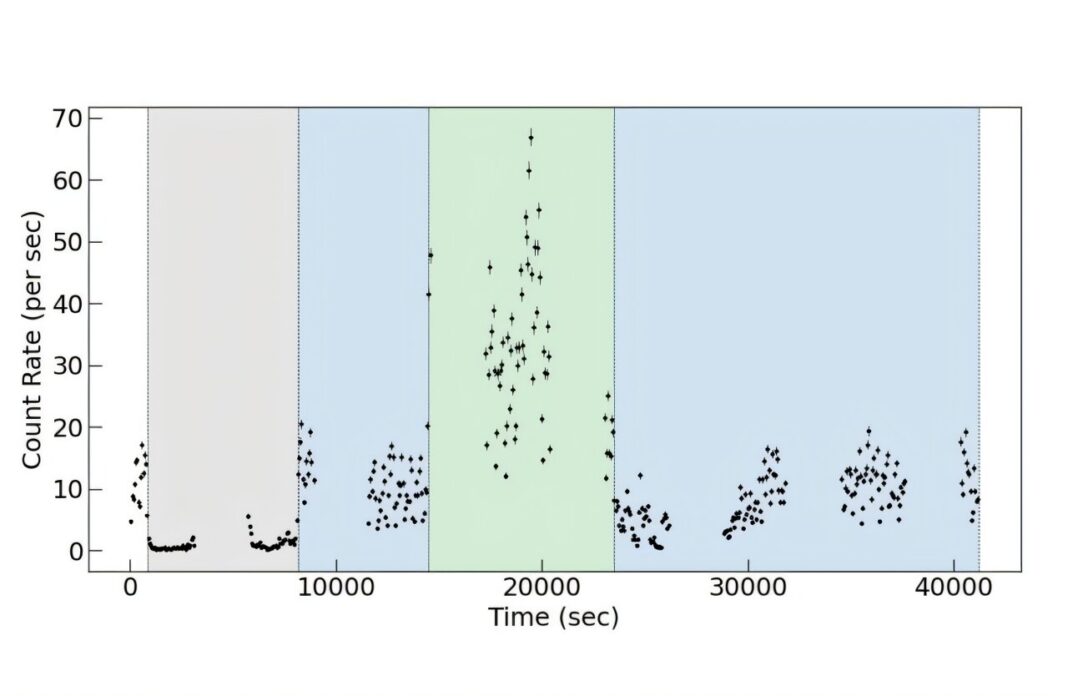Using NASA’s Nuclear Spectroscopic Telescope Array (NuSTAR), Indian astronomers have performed X-ray observations of an X-ray binary designated 4U 1907+09. Results of the observational campaign, published April 3 on the arXiv preprint server, yield new insights into the variability of this source, shedding more light on its nature.
X-ray binaries are composed of a normal star or a white dwarf transferring mass onto a compact neutron star or a black hole. Some of them are supergiant X-ray binaries (sgXBs), which consist of a compact object and a massive O/B supergiant star. The accretion of stellar wind from the supergiant star onto a compact object is responsible for the X-ray emission in these systems.
4U 1907+09 is a classical sbXB identified in 1971, located some 6,200 light years away. It consists of a pulsar and a companion supergiant donor of the O8-O9 Ia type. The binary has an orbital period of 8.37 days and an orbital eccentricity of approximately 0.28.
Previous observations of 4U 1907+09 have found that its pulsar exhibits X-ray pulsation with a period of 437.5 seconds and has a relatively constant spin-down rate. Moreover, it was found that 4U 1907+09 is a variable X-ray source that exhibits irregular flaring and dipping activities. The typical duration of the dips ranges from a few minutes to 1.5 hours.
In order to better understand the variability of 4U 1907+09, a team of astronomers led by Raj Kumar of the Bhabha Atomic Research Centre (BARC) in Mumbai, India decided to inspect this source with NuSTAR.
During the new NuSTAR observations, 4U 1907+09 was found to have different X-ray fluxes. The light curve of this source exhibits dips (off-state) and flares (on-state). During the dip, the flux of 4U 1907+09 decreased eight times during the low flux on-state, while the flux during high flux on-state increased three times during low flux on-state.
Furthermore, it turned out that as the flux varied during the on-state, the pulse profile did not differ much and followed a similar trend. According to the astronomers, this indicates that the emission process did not change during the flare activity.
Based on the new data, mainly the 3–79 keV light curve of the averaged on-state, the pulse period of 4U 1907+09 was measured to be approximately 444 seconds. This means that the source is still spinning down.
The study also found cyclotron resonance scattering feature (CRSF) at 17.6 keV in both on and off states. The width of this feature turned out to correlate positively with the flux. Moreover, the observations found that the luminosity of 4U 1907+09 during the on-state is about 285 decillion erg/s. Such luminosity suggests that the radiation in the source is emitted mostly along the magnetic field lines.
More information:
Raj Kumar et al, Variability study of classical supergiant X-ray binary 4U 1907+09 using NuSTAR, arXiv (2025). DOI: 10.48550/arxiv.2504.02791
Journal information:
arXiv
© 2025 Science X Network
Citation:
X-ray binary 4U 1907+09: NuSTAR observations reveal flux variability and spin-down (2025, April 10)
retrieved 10 April 2025
from https://phys.org/news/2025-04-ray-binary-4u-nustar-reveal.html
This document is subject to copyright. Apart from any fair dealing for the purpose of private study or research, no
part may be reproduced without the written permission. The content is provided for information purposes only.
